#and you may be missing the point of what leftism is
Explore tagged Tumblr posts
Text
Gender presentation of JJK female cast
This post contains spoilers for events in the JJK manga that happen after season 2 of the anime.
Part 1 - presentation
The first part of this post is going to be about how I perceive the gender presentation of most JJK female cast - aka the characters I’m fairly confident the author wants the audience perceive as women.
There are a few caveats I need to make up front.
First of all I will be using adjectives like feminine and female, masculine and male to describe the gender presentation of characters.
These categories stem from the cultural concept of a gender binary correlated with a biological sex binary that exists in many contemporary societies in one form or another. Concept because neither biological sex nor gender is binary. And this concept is very closely linked to traditionalist thinking, patriarchy, misogyny, right wing ideologies (including radfem ideologies) and fundamentalist religion and is reinforced by capitalism. All these forces have a vested interest in building up masculinity and femininity in opposition to one another and drawing a very clear distinction between them.
Of course as such these categories’ve been tackled by feminism, queer theory and general leftism, reinvented, reclaimed, etc.
And like pointing out the origin of masculine and feminine is not me trying to judgemental about them. It’s to explain that when I’m using them here, I’m using them in reference to their origins, to what I believe a right wing person would consider feminine or masculine. It will become clear why later.
The second caveat is that my perception on what would read more feminine and what more masculine is very subjective and deeply rooted in my own culture, my own experiences with gender and also what I’ve seen from other cultures over the years. And some of you looking at my categorisations below will think: nah, I don’t read that like that at all. I hope you will still understand my points even if you’d put some of the characters in different groups.
The third caveat is that I’ve included most of the characters but not all of them, not even all of the ones the tier maker offered. I skipped them because I considered them too background to feature, like looking at them I couldn’t recall anything about their personality or anything like that.
The last caveat is that by presentation I mean outer appearance (clothes, hair style, accessories) mixed with how the characters carry themselves and their mannerism. So like the overall visual vibe.
_
I used the tier maker website but this is obviously not a tier thing but I just found this tool easy to organise the characters, it had most of the characters I wanted to use, and it was easy to upload the one I felt was missing.
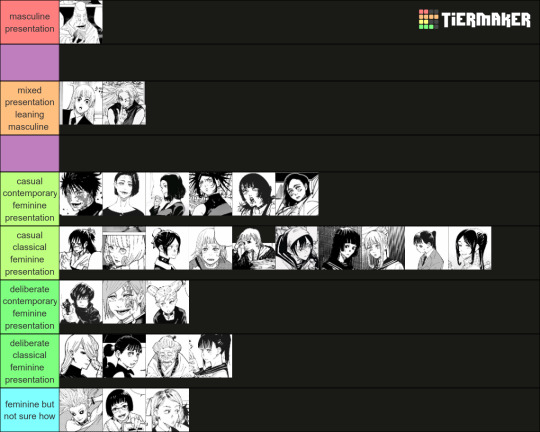
Since this is an organising effort, I actually put blank lines into it to separate the groups: masculine, mixed and feminine.
_
And just one look at it shows how the vast majority of the women in JJK neatly fit into the feminine side of the presentation spectrum.
So I divided it further. Here is my thought process behind it, and I know it may sound a bit weird.
First of all, I separated classical feminine presentations from contemporary ones.
The classical ones are for me ones that even rather conservative right wing people wouldn’t consider unfeminine, or not feminine enough. Even if they could consider some of the presentations sexually aggressive.
The contemporary ones are those where some right wing dipshits would be like: she’s not trying enough to be appealing to my very narrow view of what a proper woman looks like.
The second distinction is between deliberate and casual. So whether there are grounds in the text of JJK to believe so or whether I get the overall vibe from the character that she’s putting thought into the femininity of her presentation or whether it just feels that she just leans that way and doesn’t consider the reasons for that.
So the deliberate contemporaries all sometimes assume female associated poses and mannerisms at will and they are doing it consciously. And they seem to have an attitude towards their gender.
But they do not weaponise it like the deliberate classicals. Only Takada doesn’t do it for evil, she just does it for her career. The other four are very aggressive in their use of it. Mei Mei uses it to seduce her baby brother. Remi and Ogami to lure men to their deaths. Tsubasa to get her classmates to bully Junpei.
I don’t want to say that it’s conscious on Gege’s part, that the cursed cat put this much thought into it. But it feels in line with how this classic femininity is seen as a tool by the right wing men. A tool they want to use but also fear because they feel weak to it.
In this framing the deliberate contemporary would be not appealing enough to right wing men. It’s more a presentation that feels targeted to appeal towards centre left women.
The casual classical presentation is probably the most desired by the traditionalist crowd. Women just falling in line but not trying to wield it.
But to people who are not into policing how others look and don’t follow right wing influencers, both casual looks classical and contemporary will likely register as neutral.
I put three characters into the feminine but not sure how category. Uro has her jewellery and her body language slants feminine for me but she’s naked and I’m not sure how to read that. I also put there Sasaki and Nitta because we only see Sasaki in her school uniform and Nitta in her work clothes and after some thought I decided that I don’t want to make a decision without seeing their casual outfits, because I didn’t feel like they gave me enough of a clear vibe, unlike Mimiko, Nanako or Riko.
_
Now to the three in the masculine presentation category, or at least leaning masculine.
Yuki often vibes masculine clothes-wise and posture but it’s not 100%. She has feminine outfits, she strikes feminine poses sometimes. For me she’s very “however I felt that day” gender presentation wise.
Miwa is fascinating. I searched for JJK wifu rankings (I took mental hits for this post, okay) and Miwa is in all of them, even the short, like 5 character ones. I haven’t seen her top any of them but she’s usually high. Miwa’s uniform is a suit, shirt and tie. I had a conversation about this with cursedvibes and he said that in a professional setting it doesn’t strike him as a masculine outfit, especially that the suit is cut for a female silhouette. But culturally, where I live, because she’s not wearing a blouse under the jacket, it would read masculine to a lot of people. It only shows how culturally loaded this all is. And then he found me a drawing of Miwa in casual clothing and it’s this:
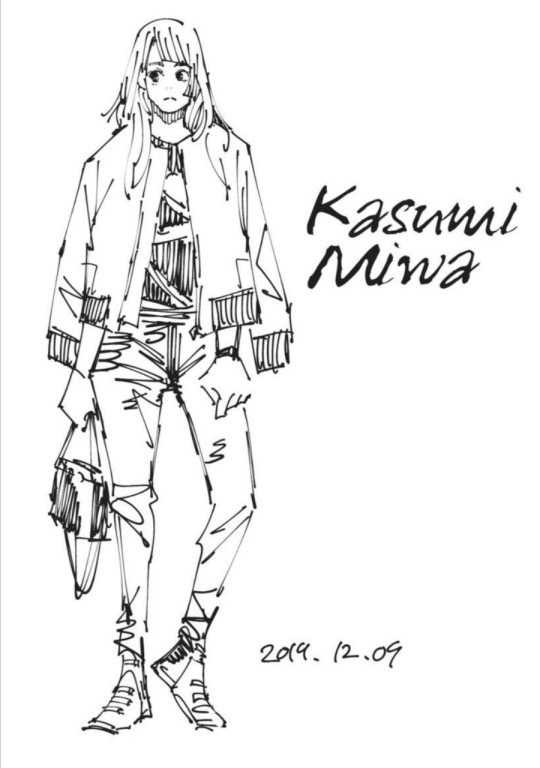
Yeah, her outfits are on the masc side but she feels so girly. I love her so much.
Tengen will look masculine in a gown:
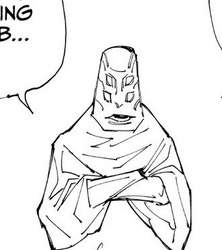
And she’s shown wearing suits with a masculine cut. Amazing.
______________________________________
Part 2 - Maki and Mai
So what prompted me to even think about the presentation of the female characters was this garbage post.
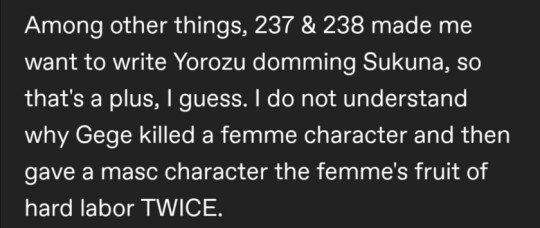
It seems to have been deleted so I cropped the author’s name and icon out. Idk why the author did that but maybe they don’t hold these opinions anymore. Maybe someone pointed out to them that that vague about Maki is deeply misogynist and lesbophobic. And since they were trying to perform a feminism with this post, they just deleted it because it wasn’t a good look. They could’ve just deleted that Maki vague, the rest of the post is inoffensive.
Maybe they actually looked at the manga and realised that fuck, they are wrong about what’s in there.
That Maki vague is very unpleasant to me on a few levels.
Before Jougo burns Maki, she usually wears skirts. She has a girly hair style. She wears the cutesy leg warmers. Maki pre burns actually tops several of the wifu lists I’ve looked at! Her appearance is read as girly and desirable by what I assume are straight male western anime fans who make these lists.
So to associate Maki so strongly with masculinity you need to buy into the bullshit that personality traits are gendered. Or that having certain ambitions, desires or priorities is reserved for either men or women.
That Maki’s ambition and/or lack of nurturing traits and/or her harsh bully personality make her by default masculine. While also pretending that Mai isn’t a harsh bully.
Even after the burns her outfit is not masculine.

It really accentuates her curves, it’s tight, it has the decorative belt and cape. Look how she poses in it. Cursedvibes said that he gets a superhero vibe from it and he’s absolutely right. Yorozu’s outfit has a similar vibe, and so do some of Yuki’s outfits.
But it also accentuates Maki’s arms. And she has amazing arms.

Her pre burns outfits don’t expose her muscles so much. Her fighting style doesn’t really emanate with that much strength.
The above post alludes to the moment of Mai’s death. The first time when Maki is wearing trousers while Mai is in a skirt in the same scene. It’s after Maki was disfigured, has shorter hair. Is in an outfit that accentuates her athleticism.
Professional female athletes get their femininity questioned all the time, they try to perform femininity during competitions with makeup, hairstyles, sometimes their outfits to counteract that. Things that male athletes don’t have to do.
And even though Maki’s outfit isn’t really masculine, it’s not as strongly feminine as her skirts because it doesn’t hide the physical strength in a palatable package. So there is some change in presentation but it’s not an obvious jump from full femininity to full masculinity.
Also scarring is something women tend to hide more than men. Scarring is culturally charged considered a blemish and any form of deviating from the norm, clear and unblemished skin, carries the possibility of ridicule. But society puts extra pressure on the appearance of women. Naoya even attacks Maki’s post burns appearance directly.
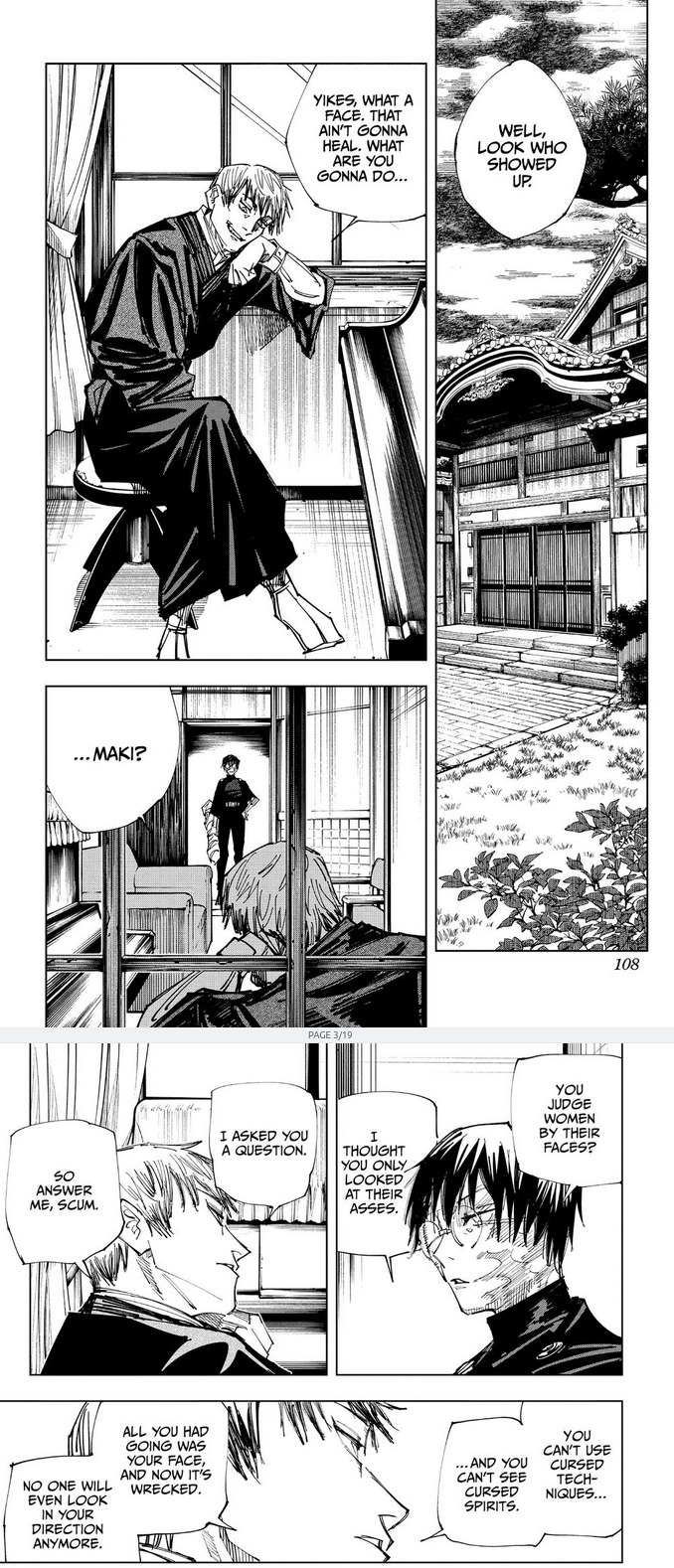
And this is the last level why that vague is unpleasant specifically in the context of Maki. Her family constantly challenged her value as a person. Tied a lot of their bullying to her not being enough. Not human enough because she had no cursed energy. And the only sliver of value they awarded to her was her attractiveness as a woman. Sliver because they despised her for not falling into the role of a meek, invisible woman, the servant to the heir.
Yet neither she nor Mai seem to have ever rejected their femininity. Maki’s rebellion didn’t go into her gender or gender presentation. And it easily could’ve. With the trauma she has it wouldn’t be strange if she had a complicated relationship with her own gender. But she doesn’t seem to and that’s also okay. And this isn’t a criticism at creators of fan art or fic that depict Maki as more butch, that include considerations of gender and gender presentation into her trauma or rebellion against the Zenin. This is specifically an issue with these kinds of takes that wear the guise of interpreting the actual text of JJK.
This is why I’ve been talking about how one needs to be careful when critiquing JJK from a feminist point of view. This is just the latest post I’ve seen where the author in their attempt to paint Gege as doing a supposed misogyny, did an actual misogyny themself. Here’s another one I actually responded to.
One of my fandom friends, Subdee, has always talked about how radfems and right wing fundamentalists are astroturfing the fandom, how many people who pursue their fandom hobbies on social media get exposed to radfem ideology masqueraded as progressive feminism or queer theory. And if these people don’t have a solid foundation when it comes to these issues they will internalise the rainbow puritanism and radfem ideology. While they also usually get dragged into these ideas that fandom is activism, that you have to present a certain ideological purity through fandom not to be a bad person. That you have to be “critical” of what you “consume” and actively seek out the problematic aspects of the works and condemn them.
And it is very clear in both the post about Maki and the one about Nobara. The desire to be “critical” and the deeply rightwing radfem ideology. Because to think that Maki is masculine and Nobara is unfeminine you have to believe in such a painfully narrow idea of what femininity can be, an idea that you could hear espoused by a far right influencer.
The Maki post actually went further than that. It hints upon other radfem ideas of any proximity to masculinity giving the person automatic privilege (aka butches have male privilege bullshit). But even if we imagined an alternative universe version of JJK which had grounds to link Maki to masculinity strongly enough for it to match Sukuna’s very obvious and aggressive traditional masculinity, there’s another radfem red flag in that post. The implication that a feminine person doing something for a masculine person is inherently an act of being exploited. Regardless of the circumstances of the situation, because the Maki/Mai situation is not even remotely similar to the Sukuna/Yorozu situation if you actually give it a few seconds of thought. The idea of femininity always being the victim of masculinity is one that inherently means that feminine people are weak, helpless and can’t make their own decisions, it strips them of any agency. It undercuts and disrespects both what Mai and Yorozu did.
_____________
post script.
I recommend the interview that Gege did together with Kubo, the creator of Bleach. There's some interesting stuff in the about how for instance someone from the industry views Gege's female cast.
(Side note, one wifu list included guys and Gojou and Megumi were higher than Yuuji! Can you believe that? He’s the only proper wifu out of the 3 of them. Disgraceful, that’s why straight people shouldn’t have the right to vote on anything, even anime wifus)
#jjk spoilers#jjk#jujutsu kaisen#female characters#femininity#masculinity#maki zenin#mai zenin#my ramblings#ramblings#i'm honestly not sure if i managed to make sense#especially in the first part#but when i was setting out divide the characters into groups i actually didn't expect that so it would be so overwhelmingly one sided#i didn't really exactly remember everyone's outfits#i just recalled how much maki favoured skirts pre shibuya
29 notes
·
View notes
Note
I've followed you for a long time and my politics shifted around the same time yours did (Trump was also what pushed me to Libertarianism, though looking back I always had more Libertarian leaning views and just didn't realize until I looked into it more) Honestly I'm sad to see you go leftist though. There's still too much of their beliefs I can't get behind (particularly economic, healthcare, and self defense related. I'm too anti gov to ever go leftist, despite being married to a democrat.) But I'm not here to argue. Just sad to see one of the few reasonable Libertarians here go. We have too many "former" republicans that won't let go of their hatred and bigotry making us look terrible and I'll miss seeing a voice of reason among them. Sometimes it's hard being sincerely libertarian in belief when the loudest members of the party are trying to turn us into republican 2.0, especially on this site where we're hated on sight. Hopefully at least you remember us for more than the bad parts and don't hate us like every other leftist here. It's so hostile 😔 Sorry, this got longer and more venty than intended.
I think your understanding of leftism may be flawed on several levels, but I’m not here to argue either. Honestly libertarianism was too unwilling to tackle the inherent flaws of capitalism for me, among other things. And at a certain point I didn’t want to be the “reasonable one” in a sea of bigotry, I just wanted to move away from bigots. 
1 note
·
View note
Text
A lot of anarchists will, in responding to Engels’ On Authority, say that his points are all good and well, but that that’s not what they mean when they talk about authority---this is a rebuke (“rebuke,” rather) so common and orthodox it can be found in Bakunin. This supposed response is laughable, as, firstly, Engels directly ridicules it in the text itself (one would be inclined to think they never even bothered to properly read it at all...):
When I submitted arguments like these to the most rabid anti-authoritarians, the only answer they were able to give me was the following: Yes, that’s true, but there it is not the case of authority which we confer on our delegates, but of a commission entrusted! These gentlemen think that when they have changed the names of things they have changed the things themselves. This is how these profound thinkers mock at the whole world.
That I am even writing these words at all, let alone the many conversations and interactions I’ve had over the years which have contributed to my doing so, is proof enough that the discourse has advanced precisely nowhere in the intervening 148 years, and that the anarchist response to us today is just as basic, and just as insufficient (indeed it is broadly identical) as the anarchist response one and a half centuries ago. If change in the face of scrutiny and new data is the mark of a theory’s coming into cognitive contact with reality, anarchism, on this, central issue at least, is clearly rather detached. To return to the point, however: secondly, and more seriously, this attempt at wriggling out of Engels’ critique (a smarmy, vapid attempt worthy of a theologian) shows that the anarchist has entirely missed the point. Engels is not saying that their definition of authority is wrong, per se, and that the Marxists’ is right, but rather that the entire category of authority, so employed, is meaningless: we Marxists are not arguing for one definition against another, but rather, we are arguing against the entire concept as a legitimate basis for the analysis of social and economic forms at all. This is why the Marxist conclusion is that ‘[t]he errors of the authoritarians and the errors of the libertarians are in principle equally metaphysical’; authority is a subjective measure, in any analysis, and subjectivity can never be the basis of an objective science (and if we are not attempting to elevate political action to a science, then what is the point? We may as well be ethicists!). If anarchists are anti-authoritarian, and Marxists are opposed to anarchists, then that must mean Marxists are pro-authoritarians, or at least pro-authority in certain circumstances; so runs the naïve line of thinking not just of many anarchists, but of a great many would-be Marxists too. Thus, the label of the “authoritarian left.” This is wrong. On the question of authority, Marxists have no stake in the “pro-” and “anti-” debate; we are neutral, as authority is every bit as metaphysical (as meaningless) a category as morality, and as such we do not consider authority to have any existence independent of other, material, processes (namely, class; the state is not a state because it has a monopoly on authority, but because it wields the authority of a class against other classes in a dialectical relationship; the authority is not “good” or “bad,” “just” or “unjust,” it simply is). Again, the positions of pro- and anti-authoritarianism are found by the scientific socialist to be equally metaphysical.
The anarchist view of authority is dripping in ethicism---indeed, it is, fundamentally, a moralising definition and stance (as is anarchism as a whole, of course)---so when they see Marxists critique them, they assume, implicitly or explicitly, that it is their ethics that are being criticised; a second-order critique, of the form “X is Y” (where Y is a positive moral value and X is the concept of authority), as opposed to theirs, which takes the form “X is Z” (where Z is a negative moral value). This can be seen in a common category of responses, such as ‘is there not a difference between punching up and punching down?’ (i.e., is there not a moral difference in the use of authority involved in repression and the use of authority involved in liberation?) They assume that we are engaging with the question on the same level they are. We are not. The Marxist critique does not occur at the level of second-order ethics: it occurs at the level of the first-order; it rejects the application of moral criteria to authority in the first place. This is one of the general points Engels was trying to get across when he despaired that ‘[h]ave these gentlemen ever seen a revolution?’: yes, authority is needed in order to fight and win a revolution, including the kind the anarchists want to wage; does this make them, or us, morally bad agents for doing so? Who cares! That is a liberal discussion for liberals to have; read what you will into the fact, therefore, that it is one that anarchists are desperately interested in.
Marxism is not a moral theory---Marx surmised this brilliantly in his pointing out that ‘[w]hat you think just or equitable is out of the question. The question is: What is necessary and unavoidable with a given system of production?’---and so when we engage with the question of authority, we are not engaging in a moral question. It very much seems like the anarchists are. This is an easy explanation, after all, as to why the debate has not moved forward in all this time: moral language is not involved in making propositional claims about the world, and as such, are not truth-apt; they cannot be falsified or verified, as they are simply not that kind of statement. (See, for example, Ayer.) This certainly seems to capture the essence of the problem: we Marxists and anarchists are simply talking at and past each other; our arguments are not clashing, resulting in a resolution or at least new disagreements, because they are saying very different things: we are making a materialist, and they an idealist, analysis of the concept of authority. Marxism is a scientific socialism; anarchism, an idealist, utopian socialism. This is demonstrated yet again when looking at the question of authority. The anarchists cannot seem to understand that Engels is not offering a different value-judgement of authority in his text (the only language they seem to be able to understand); he is offering an entirely different way of understanding and appreciating---of critiquing---the concept altogether. This is just one of many places in which the vast chasm between the Marxist and the anarchist worldviews, deceptively lumped together under the nonsense fiction of “leftism,” is highlighted.
15 notes
·
View notes
Text

I posted 313 times in 2022
That's 280 more posts than 2021!
29 posts created (9%)
284 posts reblogged (91%)
Blogs I reblogged the most:
@dingdongyouarewrong
@anarchblr
@elytrians
@sonofmeatthawsmoth
@transmortifried
I tagged 128 of my posts in 2022
#socialism - 30 posts
#communism - 28 posts
#politics - 28 posts
#anarchism - 26 posts
#anarchist - 22 posts
#socialist - 16 posts
#trans - 12 posts
#marxism - 9 posts
#leftism - 9 posts
#libertarianism - 8 posts
Longest Tag: 80 characters
#controling people will do their thing whenever and whenever they find themselves
My Top Posts in 2022:
#5
Collectivism vs Individualism
Much fuss has been made by many philosophers and theorists as to if we should concern ourselves more with the needs of individuals or collectives. These terms are often placed against each other as opposite points on a graph. Should we put first in importance the good of all, or that which is good for the unique individual?
This dichotomy is a false one. These concepts can coexist with each other very well, best evidenced by the simple fact that what is good for all will naturally be best for the most individuals. A group is nothing without its constituent parts, and an individual without others is likewise nothing. Collectivism and individualism, to consider one without the other is foolish. Both must be practiced, honestly and fully. Only through careful consideration of everyone's individual need can we do whats best for the collective, and only through best supporting the collective can the most individuals fully realize themselves.
32 notes - Posted September 23, 2022
#4
As a christian, I reckon that trans people have an invaluable perspective and that the world would be missing a lot if we trans people just didn't exist. As a trans girl, im lucky to have found a rather affirming church that has baptized me with my correct name, and i'm terribly sad that there quite a many people who get quite the opposite experience.
46 notes - Posted February 27, 2022
#3
george orwell was pretty cool, actually.
ive observed that its a fairly common thread in leftist (esspecially the more broad “leftist unity”) spaces to say “hes bad, actually” or just more generally disavow him. Considering his whole body of work and all the things he did throughout his life and the positions he held, i think this is quite far from the right thing to do.
47 notes - Posted May 27, 2022
#2
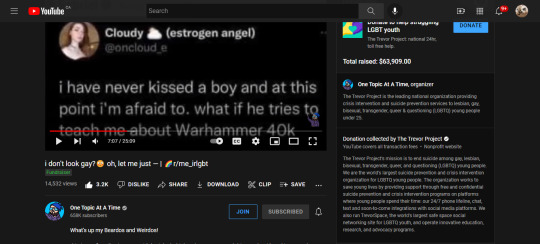

Literally everyone i talk with regularly i've brought up 40k at some point. especially on dates.
106 notes - Posted June 23, 2022
My #1 post of 2022

The sheer boldness of the lie that human rights are bad for you, actually, causes it to cyclically go from being terrifying to funny and back again, repeating ad infinitum and it shall continue to do so until we abolish wage labour (and further on the profit motive).
140 notes - Posted January 5, 2022
Get your Tumblr 2022 Year in Review →
1 note
·
View note
Text
COLLABORATIVE TASK
Please read the article and consider how 'collective' ways of working might be useful to photographic artists.
Artists assemble! How collectives took over the art world
Oliver Basciano
Tue 10 Dec 2019 07.00 GMT
Upon reading this article, I came to the conclusion that spectators create a link between politics and society within the collaboration of artists. Though effective collaborative skills, we are able to create points and a stance against certain political and societal issues; collaborating within the creative umbrella is power.
Jane Hall of Assemble, a group of architects who came together in 2010 and won in 2015, says: ‘Coming together was about trying to refigure power relationships. Recognising that, at a certain moment, the traditional rules don’t apply any more, so there’s nothing to lose in trying something different.’ I agree with this statement in the sense that artists coming together and refiguring power is an achievement and should be hounded and appreciated.
Another factor that stood out upon reflection of the article was the use of identity and sharing identity within collaborations. I believe it is important to come together as artists and use our artistic identity and culture to encourage individuals to work together. It creates power behind a certain identity and our own varied cultures. Shared identity underpins much of the desire to work as a group, says curator Charles Esche : ‘I see what happened in the Turner prize as a gesture that recognises that not everything can be reduced to winners and losers. That’s no dogmatic leftism but something more appropriate to the times in which we find ourselves.’
The idea in which occurred within the article of art coming from a single mind to a single hand which I partly agreed with. However, I do believed that art is created to be shared and appreciated by not on the creator, but with individuals in which it interests and sparks something, an emotion, within them. I trust that the use of artists working collaboratively allows that message to be translated with larger power and meaning as it has been created with alternate and varied ideas and apron approaches. As part of the article states : ‘Within the money game, the idea of the artist is still such a traditional one, the lonely figure coughing up blood in the garret. When we started showing we were asked, ‘How can you make art collectively?’ People had this attitude that art comes from a single mind to a single hand.”
I was surprised to gain knowledge of that collectives make parts of the art work ‘jumpy’. Individuals find it hard to come to terms with the fact that artists are open to collaboration, however, it does that sit well with some. Niru Ratnam, a gallerist and former art fair director, says: ‘Collectives make parts of the commercial art world jumpy. They often form in response to social or political reasons or as a conceptual gesture, which means they are probably going to produce work that is more challenging to sell.’ I can understand how collaborative art may become more challenging to sell due to its diverse response to social or political statements. However, I hope it becomes more excepting and understood. Therefore it will become easier to sell and become a more popular approach to art.
However, there was hope within the article. Sagar goes into detail when describing the political approach and possible outcomes. Sagar believes that collective working should retain its utopian aims and that it can still pose a threat to the prevailing power structures, he states: ‘Collectivity is at the heart of what being leftwing is. Collectives contain the threat of the commons, and that scares the right people, that people can come together and produce complex methods of thinking that might work against capitalism.’
I trust that working collaboratively for photographic artists is definitely an approach that should be considered more. Our use of narrative and the power of the camera is underrated. The amount of power that can come forward within an image is meaningful and can ultimately change individuals views or opinions on topics that are currently relevant in the work for better: using photography as a tool for change. Narula concurs that the pull between optimism and frustration that spurred Raqs to form in 1992 still drives them today. “Working together was born out of a certain attitude in politics and life. At the heart of it, we believe collective action could make the world better.”
Further Examples
I believe that working collaboratively can occur in many forms. Whether its collaborating with an individual that works within the same creative practice as yourself, working with an individual within a different creative practice or working alongside an individual who is able to enhance your work, your practice, to bring forward a larger and more powerful message to a viewer. A collaboration does not necessarily have to occur between two individuals, it may even thrive more effectively within a larger group, a community, that all work in a cohesive manner and create something, a collective action that could make the world a better place.
Pablo Picasso and Gjon Mili: Drawing with Pure Light
It was 1949, and a 68-year-old Pablo Picasso was spending time at his French home in Vallauris when Gjon Mili paid him a visit. At the time, Mili was a photographer for LIFE magazine and had come by to take some pictures of the great artist’s creative process. That’s where an incredible idea was born! Picasso and Gjon decided to collaborate on exploring the possibilities of painting with light. It was Mili who wanted to experiment with this technique, and he convinced Picasso to try making several paintings using the flash of a light as paint and air as the canvas.
Picasso took his assignment seriously. He was so inspired that his hands started moving around in flashing cuts, creating some of the most amazing light paintings, and Mili was there to seize the moment. Their collaboration extended for five sessions resulting in 30 images altogether.
Whether it was Picasso’s signature or a bull-shaped light trail that remained invisible until the photographs were developed, this art collaboration delivered one-of-a-kind artworks.
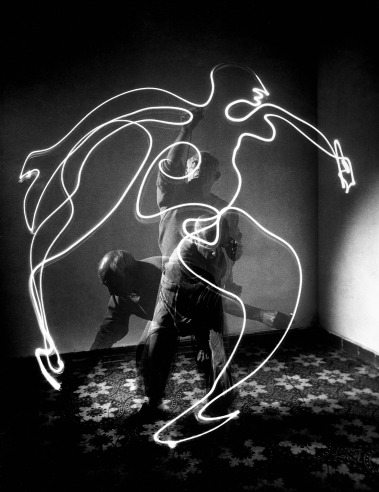
Gjon Mili ©Time & Life Pictures/Getty Images

Gjon Mili ©Time & Life Pictures/Getty Images
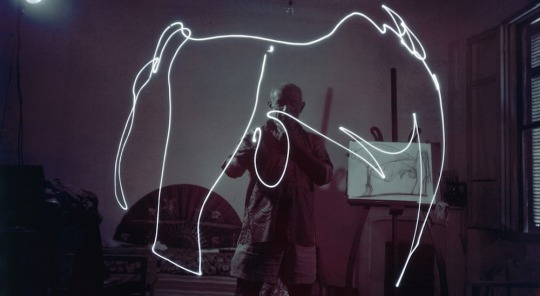
Gjon Mili ©Time & Life Pictures/Getty Images
Andy Warhol and Jean-Michel Basquiat: A Crazy Art-World Marriage
From 1980 to 1986, renowned Pop artist Andy Warhol and a graffiti prodigy, Jean-Michel Basquiat, collaborated on a number of exciting pieces that actually led them to the position they now have in the art world. Their working process went on like this: Warhol usually painted first, and then Basquiat entered the scene with his colorful imagery. One of the most popular examples would be the piece titled Olympic Rings, completed in 1985. Warhol actually made several variations of the Olympic five-ring symbol, to which Basquiat responded with the oppositional graffiti style.
How did this “crazy art world marriage”, as Victor Bockris called it in his book, Warhol: The Biography, happen in the first place? It was due to the fame Andy Warhol had already achieved and the fact that Basquiat, a 20-year-old artist at the time, thought this fame was the missing piece which would help him with his big breakthrough in the art world. And he was right! Basquiat’s emotionally-charged paintings and graffiti art were about to become some of the best known Neo-Expressionist artworks in the U.S.
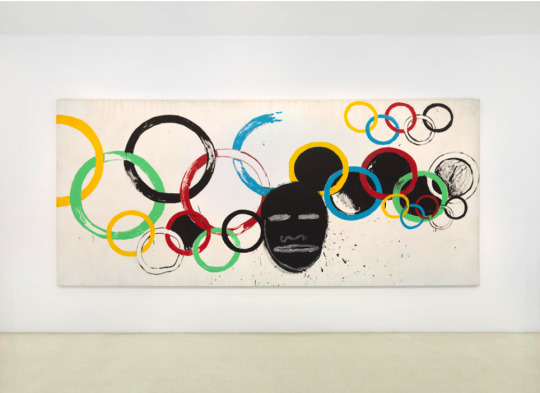
References:
https://www.theguardian.com/artanddesign/2019/dec/10/artists-assemble-how-collectives-took-over-the-art-world
http://resourcemagonline.com/2013/04/light-drawings-by-pablo-picasso-and-gjon-mili/24125/
https://www.agora-gallery.com/advice/blog/2017/04/27/famous-art-collaborations/
http://resourcemagonline.com/wp-content/uploads/2013/04/2_Gjon-Mili-%C2%A9Time-Life-PicturesGetty-Images.jpg
http://resourcemagonline.com/wp-content/uploads/2013/04/3_Gjon-Mili-%C2%A9Time-Life-PicturesGetty-Images.jpg
http://resourcemagonline.com/wp-content/uploads/2013/04/k9l3K.jpg
https://gagosian.com/exhibitions/2012/jean-michel-basquiat-and-andy-warhol-olympic-rings/
0 notes
Text
Assisting Rivals
Are Donald Trump's worst enemies trying to make his life easy? The epitome of infuriating advantages is the last guy who needs something handed to him. But the Resistance uses fantastic miscalculation to help the person they spend every waking moment attempting to topple, along with some snooze time. Demonstrating they know nothing about human nature is a bonus throw-in. Trump's never going to understand the free market if he only has to compete with businesses selling handfuls of dirt. They're even worse, which doubles as his campaign slogan.
The biggest enemies helping is how Trump got to be such a titan. Histrionics don't just make humans pleasant: it keeps them rational. Liberals are spending the term obsessed with loathing the crude brute to the point where they enable his reelection. It's not just the utter rabidity that frightens voters, although foaming at the mouth is a sign that one may not be thinking clearly. Indulging in extreme leftism that reads like parody is as wise as it is practical.
Trump can point to idiocy. No, not his own. That other party is out to provoke voters into supporting them. It beats coming up with pleasant ideas. Can you out-shock Howard Stern? Like when his show was fun instead of the politically correct weenie fest it is now? As for another entity that now runs from fun, Democrats have embraced infanticide and economic dreams that people's republics would consider excessively envious. Media accounts of potential 2020 candidates sound like Republicans demonizing foes when they're merely quoting speeches.
What have I done? Well, they suck! You may have noticed Trump's fondness for noting everyone else is the worst at everything when asked specifics about accomplishments. He knows exactly what's wrong with your actions. Quarterbacks shouldn't have thrown those interceptions. In some cases, the professional moaner has a semi-point about others, as present Democratic lunacy is easy to mock. After all, it's his full-time job.
Best of all for Trump, he doesn’t have to defend anything he’s done. Instead, he merely gestures to maniacal cultists who are sad they missed living behind the Iron Curtain. All he has to do is be the second-worst option. Like having the wisdom to be Fred Trump's son, his best decisions are made by a universe with a cruel sense of humor.
How could a cussing ape like Trump possibly luck his way into a second term? Also, the party against him thinks the best alternative is unabashed socialism. Wholly moderate dissenters liked China until it sold out. The New Great Leap Forward will be in the 2020 Democratic platform. Nothing is green like spending every moment tilling the Earth with your comrades.
It's become a dare to support them. Democrats figure they can go crazy because so many voters will choose them over the arrogant buffoon from that dumb NBC show who you'll recall is somehow president. But, like all statists, they misread the market. Members of the New Shining Path think nobody would possibly shop elsewhere. That sort of thinking is the tragic flaw of wanting the government to be the only seller. The only other downside is broken misery.
Deciding which take on lunacy is preferable makes politics fun. Democrats should congratulate themselves on making Trump look relatively stable. I'm almost impressed. Voters are more likely to go with the guy who was in charge while people were sort-of free to earn again. All he had to do was not be Barack Obama to get the economy to improve. Make sure to express gratitude to his predecessor for helping the incumbent.
The purported Republican calls your bluff, too. A guy who's kept the government intimately involved in your health care and presided over the debt growing to over 22 freaking trillion dollars knows there's no better way to go. Hopefuls to dethrone him are elbowing each other to demand single-payer while claiming there's just not enough federal involvement in your life. You don't have a good choice, so look to the less bad one.
In the ideal world we live nowhere near, Trump would be loathed by conservatives for being the precise sort of liberal sellout Republican about whom he bitches. Simultaneously, he helps liberals by conforming to their stereotype of a heartless tycoon. But the guy who makes Nixon look like Reagan just has to gesture to a row of Democratic competitors in straitjackets demanding you cooperate by law. Tax rich people who shouldn't be allowed to exist to fund our new venture.
Yes, we told your grandma to sod off. But the other route leads to infant-punching angel dust aficionados, so you really must stick with us. Trump doesn't have to be good at anything: he just has to not be them. Saying everything else is inferior has spurred every success he's ever had. A victory over Hillary achieved by being the one person other than her with a chance was brilliant. Switching to socialism as his opponent just shows how savvy he is at happening to compete with dolts.
0 notes
Text
Beyond The Tracks
Eastside Park, Birmingham
Friday 15th September 2017

I had arrived early. This is not unusual, when it says on the tickets that the doors open at a particular time, I interpret that as meaning that if I arrive later I will have missed something. Experience has taught me that the only thing I will miss is the opportunity to get a drink from the bar without queuing but that never brings me to my senses. To make matters worse, and much to the annoyance of my wife, I also completely overestimate the time it will take me to get there meaning that I mostly arrive at least 15 minutes before I can get in. I am not alone in this, there are always a few others standing around kicking their heals outside before they are able to enter and do the same thing inside. I therefore made sure that the train I caught arrived in Birmingham about an hour and a half before the 2:00pm start, it could have been late or cancelled, best to avoid the risk, and after having some lunch, even I wouldn’t stand around for that length of time, I arrive at Eastside Park at 1:45. The open space that forms the park has been enclosed by a solid fence through which there is a single access point around which a small group of people have started to gather. The purple pyramid of the stage can be seen above the fence and alongside this stands the once proud facade of Curzon Street Station, soon to find a new life as the terminus for HS2. From the entrance, a walkway leads to Millennium Point and this provides some shelter for those few waiting as the rain starts to fall from the grey clouds overhead. Despite the rain, a small queue forms at the scheduled time but with what sounds like a last minute soundcheck still taking place, there is still more waiting before we eventually pass through the security check and onto the site.

With these moments to spare, I spend my time gazing at my phone, following a story unfolding over a billion kilometres away. As I pulled my coat around me for a little extra warmth, a small probe is passing inside the orbit of the icy moon of Enceladus and making a final precarious traverse through the rings of Saturn. It is a journey from which it will never return; unlike Voyager that will spend its life drifting through the vast emptiness of interstellar space, Cassini’s fate is much more violent. Its final image shows the blurred mass of clouds into which it will soon plunge, Saturn’s haze gives the impression of a smooth benign world in contrast to the storms that are written onto the face of Jupiter but this is but a thin disguise. Careering into the atmosphere at a speed of tens of thousands of metres every second, any of it that survives the temperature will be thrown around by winds that reach over 500 miles per hour circling around planet sized cyclones. The once proud space ship reduced to particles little bigger than a few atoms and remaining a part of the planet until that itself is brutally destroyed.

Saturn’s thin atmosphere would carry the final cries of the probe as it is ripped apart but Cassini has spent most of its twenty years in the silent vacuum of space. In our imagination, however, there is a music to this emptiness, the strange other worldliness of the theremin in 50s sci-fi, the serene majesty of “The Blue Danube” to accompany a gracefully revolving space station in “2001 A Space Odyssey" and the resplendent anthems John Williams wrote for “Star Wars”. The maelstrom into which Cassini has descended however, requires something more terrifying, something like the big beats and wild electronic sound of Orbital and in particular the awesome “Satan”. The repeated title sets the tone, the thumping beat is relentless and carefully assembled sounds and samples build to drive the music through its nightmare journey. Images flash on the screen, symbols, faces, the soundtrack to destruction. A thrilling moment of utter desolation fitting for Cassini’s violent grande finale.

Standing on a raised platform behind the screens, for most the set you are aware of the presence of Paul and Phil Hartnoll through the lights that sit on the side of their head. There may be an entirely practical reason for these, allowing them to see what they are doing, but its gives them an identity whilst also providing a hauntingly strange image. As they prowl the stage in preparation, like many in their field, they are quiet, sober and look slightly awkward when someone in the audience yells out to them. With the lights in place, however, they become wild mad scientists creating the trance inducing sounds that vibrate through every muscle and encouraging the audience to ever greater levels of energy sapping movement. The repetitive beats are ever present but the intensity varies, moments of calm in between the peaks that unleash a frenzy of wild headbanging. The open sky and muddy ground recalled their early guerrilla raves in fields around the M25 but Orbital’s designs were always more inventive, more intricate and more melodic than many of their contemporaries. The setting is safer now; warnings outside, searches as we enter and high profile security make it clear that a drug induced daze is no longer part of the experience and aside from a few whiffs of cannabis, no one seems to be on anything stronger than Mad Goose and the music itself. Little else is needed and in any case, the average age of the crowd would indicate that youthful recklessness is something that was long ago left one of those home counties fields; it is rave nostalgia we are here for.

This short tour of European festivals comes after a break of five years during which time the two brothers have worked on separate projects. Their most recent album, “Wonky” appeared five years ago but they haven’t been entirely idle and whilst much of the set is familiar, it has been reimagined and adapted so that the sounds from different parts of their career can merge into one unyielding whole. “Halcyon” gains the singalong sample of “Heaven is a Place on Earth” whilst “Wonky”, despite its recent origin, has gained extra, well, wonkiness. The remorseless Acid House rush of “Chime” sounds as fresh as it did over a quarter of a century ago but a city centre means that rather than an all nighter, there is a strictly enforced curfew. As the bleeps and grind of “Where Is It Going” bring the set to a close, it all seems as if we are only just getting started. As we move away from the stage, the ghostly imprint of those four white lights is retained as we make our way into the darkness of the park.

Many years ago I was directing a production of “Measure for Measure” which I chose to set in a bleak and polluted post industrial landscape overseen by a military dictatorship, it seemed like a good idea at the time. Music was an important part of setting this scene and to achieve this I used snippets of tracks by The KFL, Nine Inch Nails and Can. Alongside these, I also used music from an album that I had bought about a month or so earlier and fitted what I wanted perfectly. About a couple of years later, I was acting in a production of “Closer” and as a background for the scene in the lap dancing club, the director had chose the same album unaware of my previous use of the music. In both cases, it worked perfectly, creating an unsettling mood to underpin the complexities in the drama. The album was, of course, “Leftism” and to hear it performed in its entirety was a reminder of just how breathtaking an album it is. “Release the Pressure”, the first track and one I had used all those years ago, is magnificent, building relentlessly from its quiet opening, increasing the tension until the full force of the thunderous beats can be unleashed. It does exactly what it says it will do and as MC Earl Sixteen, one of several original contributors, adds his plea for “peace and unity”, the thrill of starting the journey is as great as ever. The ferocious and dizzying chant of “Afro Beat” is spectacularly delivered by vocalist Djum Djum who also adding the freakish sound of a theremin, there had to be one around, towards the end. It is the dynamics of “Leftism” that makes it such a flawless album and after the unrestrained rush of the first two tracks, “Melt” provides an opportunity to become lost in its serene beauty.

The sole original member of Leftfield is Neil Barnes who, until the end when he moves to the front to thank us and tell us how emotional it has been, spends most of the set hidden away behind banks of keyboards at the back of the stage. To his right another band member adds additional keyboards but it is interesting to note that, unlike Orbital, he does not rely entirely on electronics to create the sound. A drummer is there to provide most of the heavy beats and during the set, Barnes uses a melodica and what looks like a home made single string percussive instrument to add some acoustic textures. Despite the thumping beats that underpin it, “Original” offers a little more respite but is let down a little by the limited vocal abilities of the singer. The unstoppable force of “Black Flute” and “Space Shanty” leads to an incredible “Inspection Check One”, two MCs prowling the stage repeating the title as the rhythms pound out of the speakers. It was an incredible moment but topped by the unbelievable “Open Up”, the mighty presence of John Lydon’s still potent despite only appearing as a back projection of the original video recorded over twenty years ago. Extended well beyond its original length, its remarkable energy allied to Lydon’s sneer captures one last ecstatic moment before the solemn come down of “21st Century Poem”. Then, abruptly, it was over, Barnes makes his rare foray to the front of the stage humbly accepting the applause, the reluctant driving force behind the astonishing creativity.

Whilst we were keen to seen both of the main acts this evening, for us it was Leftfield that were the main draw. It only takes one thing to affect the best laid plans, however, and today we had several. Firstly, Claire was summoned to a meeting in London, secondly a fire in Milton Keynes closed the line back to Birmingham and thirdly an “incident” at Princes Risborough also closed the main alternative route back. The result was that she only made it back in time to see Lydon leering “burn Hollywood burn” from the screen at the back of the stage, missing most of Leftfield and the two bands that preceded them. Of these Jagwar Ma’s indie dance was perfect for a festival of 90s nostalgia. Guitar and nimble bass are pretty standard but it is the keyboards and programmed drum from the third member of the band that provide the rhythm and add a distinctive quality to their sound. Appropriately the sun decided to put in an appearance for the sunshine psychedelia of “Come Save Me”, prompting the singer to comment that it is the first time he has seen it since their arrival in the UK; they are from Sydney. Needless to say it is soon raining again. Arriving first, the audience for Pixx is sparse but they do well to overcome this and draw those who have arrived early to the stage. They have a rather more conventional line-up, including both drums and bass to lay down the rhythm, but above this airy electronic textures help to create wonderfully atmospheric textures for the sombre lyrics. The distorted time signature of “Romance” forms a compelling highlight and she also includes an excellent cover of Joe Jackson’s “It’s Different for Girls”. A late DJ slot from Sister Bliss gives a reminder of the sheer exuberance of Faithless, culminating in the infectious groove of “Insomnia”.

The festival runs for another two days but from now on electronic dance music makes was for indie show gazing. There was something quite special about the inner city setting, with trains passing on one side and apartments overlooking the park on the other, there was a definite feeling of the city carrying on as normal while the party was going on. The organisation seemed good, the site seemed to clear quickly although the queues for the bar and toilets did seem to be quite long at times. The park seemed full although I suspect short of the 5000 sales they were aiming for, emails offering weekend passes and reduced price tickets for the Sunday suggested that sales had been a little slower than predicted. The strong line-up, however, did bring people in from further afield, the man we chatted to as we waited for Orbital had travelled down from York and I even heard of a couple who had flown over from the New one. It seems unlikely that the festival will be repeated next year but the hope is that an inner city festival will soon become a regular feature in Birmingham. Earlier this year Orbital played the Bluedot Festival at Jodrell Bank where they were able to start their set with the rhythmic signal of a collapsing star picked up by the Lovell telescope. Whether they were aware of the final signals picked up from Cassini today I cannot say but in their audience there was one who briefly raised a glass.

0 notes
Text
PowerLine -> In the Ninth Circuit – Back to the future with Nancy Pelosi
9th Circus Court of Appeals at HoaxAndChange.com
presidential immigration bans at HoaxAndChange.com
Immigration pause order Ok for Obama, not so much for Trump at HoaxAndChange.com
Daily Digest
In the Ninth Circuit
Hans Rosling, RIP
Fashion statement
The Audi factor
Back to the future with Nancy Pelosi
In the Ninth Circuit
Posted: 07 Feb 2017 04:28 PM PST
(Scott Johnson) The oral argument of the Trump administration’s motion for a stay pending appeal of Judge Robart’s order restraining the Trump administration from enforcing the executive order calling a brief timeout on the admission of refugees from seven designated countries (a/k/a “travel ban”) in the Ninth Circuit just concluded. The Ninth Circuit made the oral argument accessible by live stream.
To no one’s surprise, the oral argument did not go well for the Trump administration. All three judges were all over Department of Justice special counsel August Flentje. Flentje himself turned in a pitiful performance. The Ninth Circuit has promised to post a recording of the oral argument here as soon as it is able to do so.
It’s been a long time since I worried about appellate jurisdiction, but I doubt that the Ninth Circuit has jurisdiction to entertain the appeal that the Department of Justice has filed. This question was addressed only at the outset of the argument presented by the State of Washington Solicitor General on behalf of Washington and Minnesota. In my opinion, any outcome remotely favorable to the Trump administration is extremely unlikely at this point, though (again, in my opinion) it has a strong case on the merits of the issues.
Hans Rosling, RIP
Posted: 07 Feb 2017 11:44 AM PST
(Steven Hayward) I’ve got a heavy class schedule today, but I just saw the sad news that the great Swedish demographer and statistician Hans Rosling has died at the too early age of 68. He’s not called “the Jedi master of data” for nothing.
Among other great creations of his is Gapminder, where you can visualize all kinds of data. I’ve used the site a lot in the classroom with students to teach data analysis and especially trend analysis. You can find a lot of Rosling’s great short videos there.
I know I’ve shown this one before here, but it is my favorite. And special bonus: feminists don’t like it. It’s 11 minutes long, but worth every minute:
Fashion statement
Posted: 07 Feb 2017 10:27 AM PST
(Paul Mirengoff) In case you were wondering, the profound political thinkers in the fashion industry are “dismayed, angry, and frightened” by President Trump. So reports Robin Givhan, the left-winger who covers fashion for the Washington Post.
Givhan tells us that designers are processing this dismay, anger, and alleged fear of Trump through their shows. One designer featured “beefy men in black velvet.” Givhan explains that this was “a brooding commentary on life in this moment.”
Or perhaps a nod of approval towards the black-attired thugs who riot in our cities in protest of Donald Trump or for some other pretext de jour. Or maybe just some fantasy that has nothing to do with Trump.
A German designer gave a more explicit shout-out to the thug protesters. He dressed his models in “purple camouflage overcoats, flame-red satin trousers, [and] neoprene face masks.” Not one of the peaceful protesters I saw in Washington on January 21 wore a face mask. That was the gear of the January 20 rioters who injured police officers, destroyed vehicles, and hoped to avoid detection through attire that made them difficult to identify.
Another presentation “opened with models standing in the cramped confines of a prison yard — a tight square surrounded by chain-link fencing and lighted from above with spotlights. Black-clad guards stood sentry.” Then, “one by one, the models stepped out of the cage to walk confidently into the light and stand atop a platform” to a soundtrack that “featured quotes from Malcolm X, Cesar Chavez, even RuPaul.”
Given explains:
The story was not simply about race, but also gender, sexual identity and ethnicity. Chavarria eloquently tapped into concerns roiling the nation, and he used the power of fashion to underscore our stubborn reliance on stereotypes and appearances, the way we segregate ourselves into opposing social tribes.
Or into criminals and non-criminals.
This presentation simply channels standard-issue modern leftism. It’s open to question whether it had anything much to do with Donald Trump.
The same question applies, I think, to most of the antics we’re seeing from the left. Would leftists behave much differently if Ted Cruz, or any Republican who ran as a conservative, had been elected president?
I doubt it. The protesting crowds might be a little smaller and we wouldn’t be seeing “pussy hats,” but the atmosphere would be basically the same.
The fashion community would be dismayed, angry, and frightened. In all likelihood, it would still present beefy men in black velvet and models posing as inmates.
The left thinks it’s smarter and more enlightened than the rest of us, and thus entitled to rule. In this respect, it mirrors the fashion industry which seeks to dictate our tastes.
Donald Trump’s election is unacceptable to leftists mainly because it deprives them of the power to rule. A Ted Cruz or even a Marco Rubio presidency would be unacceptable for the same reason.
Trump gives the left an excuse to “act out.” Maybe it would be a little more cautious if some other conservative were president. In the case of the fashion industry, probably not.
By acting out, the left runs the risk of further alienating those who, though not natural Republicans and not in some senses conservative, gave Trump the votes he needed to prevail. I doubt that many of these voters would be impressed by the presentations Givhan describes (you can see pictures via the link to her story).
More likely, they would be dismayed and maybe angry or frightened.
The Audi factor
Posted: 07 Feb 2017 07:31 AM PST
(Scott Johnson) The “wage gap” between men and women is such an old canard that it could be coeval with the birth of (real) fake news. With their sure grasp on the exploitation of ignorance, Democrats have turned it into a perduring plank in the “war on women” allegedly waged by Republicans. Thomas Sowell has devoted several columns to debunking it. He calls the “wage gap” a “lie that won’t die.”
Where would the left be without “gaps” to remedy? The “wage gap” will never die.
On Sunday it turned up in a Super Bowl ad run by Audi (video below). What was it doing there? That is a good question in more ways than one.
The ad caused gratuitous offense to anyone who understands the game that is afoot. Speaking for myself, I can say the ad probably lost Audi a few customers. It probably lost them a few prospective customers. I wonder how many it may have gained them, or whether the good will Audi sought to create was offset by the offense it occasioned.
What about Audi itself? It turns out that there is a “wage gap” at Audi. It turns out that Audi has no women on its board. Ashe Schow reports on the ordeal of Audi in her debut New York Observer column. Here is the beauty part:
Audi…basically debunked their own Super Bowl ad on Twitter. After tweeting their commercial, one woman responded, asking if Audi pays their female workers less.
“You pay your female employees less than males?” she asked. “You know that’s against the law, right?”
Audi’s official Twitter account responded: “When we account for all the various factors that go into pay, women at Audi are on par with their male counterparts.”
So when they have a wage gap, it’s due to “factors,” but everyone else’s wage gap is due to discrimination.
This is the same tactic the Obama White House used when it was discovered women, on average, were earning less than men. The gap was due to more women in junior positions, with more men in senior positions. But when earnings are compared, women as a whole are compared to men as a whole.
Audi learned this the hard way after the Super Bowl ad aired, when people started noting that no women sit on its management board….
Thus the difference between Audi and Democrats. Democrats are incapable of embarrassment and they will never learn.
Back to the future with Nancy Pelosi
Posted: 07 Feb 2017 05:47 AM PST
(Scott Johnson) House Minority Leader Nancy Pelosi has served in Congress a long time. She has served long enough to oppose Republican presidents going back to Ronald Reagan. In the modern era, she has missed only Presidents Eisenhower and Nixon, but she opposed them too! Make no mistake about that.
She has served in Congress long enough to oppose both Presidents Bush, father, and son, over a period of twelve years. It, therefore, makes perfect sense that in a press conference yesterday she confused her current opposition to President Trump with her opposition to the Presidents Bush in ages past (video below). Long may she run.
[amazon_link asins=’0822586851,B00QL9KLOO,B002RGXDQS,B01BPKYNKG’ template=’ProductCarousel’ store=’hoaxandchange-20′ marketplace=’US’ link_id=’ff642094-ed99-11e6-a2e2-37ecfe69f70b’]
The video illustrates the Democrats’ depleted bench. It illustrates the courtesy extended the Minority Leader by her less tenured colleagues, who seem to note her slip but let it pass. It illustrates a variant of the Freudian slip or the persistence of memory. It illustrates the ghost in the Democratic machine. Who ya gonna call?
Via Brent Scher/Washington Free Beacon.
PowerLine -> In the Ninth Circuit – Back to the future with Nancy Pelosi PowerLine -> In the Ninth Circuit - Back to the future with Nancy Pelosi Daily Digest…
1 note
·
View note